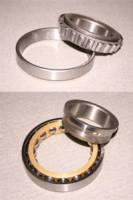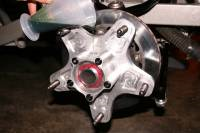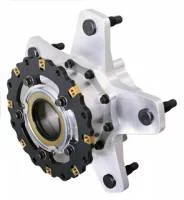Finding speed a little at a time is the way to the front. A few horsepower here, less drag there coupled with a good shock change might add up to half a tenth on a good day. Reducing rolling resistance is one of those speed secrets that works continuously but it is hard to measure in the real world. Still – if your car has less rolling resistance common sense dictates that your race car will be faster.
Cup teams go to great lengths to measure improvements in rolling resistance. Several Cup crews have traveled to a hidden hill to test their ideas relating to reducing rolling resistance. The teams drag the car up to the top of a steep hill and set up to test roll the car down the steep grade to determine how far it will roll with out the help of the motor. They let gravity propel the car until it rolls to a complete stop. Teams test different roll resistance ideas celebrating the smallest improvement in free roll distance.
While your team may not be able to test rolling resistance on a secret hidden hill you can try some of the latest rolling resistance tricks. Running your hubs “wet” with low friction bearings and seals will reduce rolling resistance and increase car speed. You can really feel the difference based on the effort of pushing your car through the pit area. Oil filled hubs are the new rage and coupled with low friction seals you get many benefits. One spin of the hub with your hand is enough to illustrate the reduction in friction.
We like to run oil filled hubs for improved speed. Low friction seals and bearings combined with 85/90 weight gear oil result in hubs that spin freely. We also likes the maintenance aspects of running oil filled hubs. Rebuilding and re-greasing standard bearings is an all night job – with oil filled hubs you can quickly drain the oil and inspect the fluid just like you inspect motor oil in a screened filter. Each week, if the hub oil is clean, clear and free from metal particles you can just refill with 4 ounces of new fluid and be ready to race. In the rare event you need to replace your oil filled bearings, the job is much faster because you can just pour in the oil instead of making a time consuming mess packing bearings with old school grease.
What is the right amount of oil?
 When running the hubs wet it is important to add the right amount of gear oil. 4 to 7 ounces is recommended by the car builders we surveyed and your team should monitor the fill level to ensure proper coating of your bearings. High quality synthetic lube is required.
When running the hubs wet it is important to add the right amount of gear oil. 4 to 7 ounces is recommended by the car builders we surveyed and your team should monitor the fill level to ensure proper coating of your bearings. High quality synthetic lube is required.
You can experiment with the right amount of oil if you run your hubs wet. We recommend 4 ounces but other builders and hub manufactures may have their own recommendation. Our survey of car builders resulted in a recommended hub oil fill range from 4 ounces to 7 ounces utilizing synthetic fluid. As running hubs wet is a new speed secret you should keep an eye out as the fill level recommendations will change based on testing, fluid type and the evolution of manufacturers specifications.
Bearings
 Low friction roller bearings or Teflon coated tapered bearings will lower your rolling resistance where you need it most. Roller ball bearings should be inspected often and need continuous maintenance.
Low friction roller bearings or Teflon coated tapered bearings will lower your rolling resistance where you need it most. Roller ball bearings should be inspected often and need continuous maintenance.
Chuck Carruthers of Chuck Carruthers Industries says that only 5% of his customers are running hubs wet. Carruthers states: “Using Teflon coated bearings with 4.25 ounces of 50 weight synthetic gear oil gains 6 to 8 coast down horsepower”. Chuck prefers traditional wheel bearings and pays the extra cost for the Teflon coated version. Chuck feels the low friction roller ball style bearings are risky in long races. Carruthers says; “we get plenty of friction reduction from Teflon coated roller bearings and would rather avoid the added wear seen in roller ball bearings”. At Carruthers Industries they are careful and run the minimum amount of hub oil to ensure parts are coated but avoid running too much fluid as excess fluid in the hub can actually add heat. Chuck says “you want enough fluid to coat the bearings but any surplus fluid can foam or even impact how heat transfers and dissipates through the hub”.
Torque Settings
 Weekly draining and refilling of “wet” hubs is simple. Fresh oil helps your parts and their longevity. Using a locking hub nut will ensure that your hub maintains torque even at lower torque settings.
Weekly draining and refilling of “wet” hubs is simple. Fresh oil helps your parts and their longevity. Using a locking hub nut will ensure that your hub maintains torque even at lower torque settings.
With the “wet” system and Teflon coated bearings Chuck recommends running 15 to 20 ft pounds of torque on the front hubs. He advises that you can run less on the rear as the brake heat is less intense. Chuck says 10 to 12 ft pounds on the rear hubs works great. Reduced preload on the bearings reduces rolling resistance creating more speed. Chuck reminds us “be sure to use a locking hub nut to ensure your torque setting stays put from cold to hot”.
Carruthers pays attention to detail and has made a special hub adapter for measuring hub torque. Chuck advises: “When our customers are doing their own work we have them torque the hub nut to our recommendations with a good foot pound torque wrench – we give them the setting and they simply torque down the hub nut and lock it down. For the cars that we maintain in our shop we go the extra mile and use a hub adapter that connects to a high quality inch pound torque wrench – the adapter connects to the torque wrench at the hub center. We add oil and give the hub a spin ensuring the hub and seals are lubricated. We then use our inch pound torque wrench with our custom made centering adapter. We adjust the hub nut until we have 28 inch pounds of drag torque when rotating the hub with the torque adapter at cold temperature. When the hub is hot we know that there is minimal torque on the hub providing for optimal reduction in rolling resistance. At race temp we see about 3 to 4 inch pounds of drag torque with our custom measuring device”. Care should be used with this process as if the specs are not followed exactly you could end up with too little torque resulting in failures. Weekly inspections and pre-race checks are needed when pushing the edge in this fashion.
Floating Rotors
 Using a floating rotor with a T-Nut package allows the rotor to expand through the heat range. The movement allowed by the rotor flange is isolated from the hub resulting in less drag. This hub has a seal retainer system that lets you remove and replace expensive low friction seals with out damage.
Using a floating rotor with a T-Nut package allows the rotor to expand through the heat range. The movement allowed by the rotor flange is isolated from the hub resulting in less drag. This hub has a seal retainer system that lets you remove and replace expensive low friction seals with out damage.
While at the 2008 PRI show a confidential source explained the secret testing their team performed relating to floating rotors. Since my confidential source did not want to get fired by his team he wants his name kept out of this article. The secret tests performed by his high profile team revealed that running floating rotors added 6 horsepower on the chassis dyno. Making 6 horsepower due to brake efficiently – seems crazy! The HP gain is due to the floating rotors finding center through out the heat expansion range. The T-nut set up and rotor flange allows for a bit of movement that absorbs rotor warping and isolates it from the hub resulting in less brake pad drag. You get the horsepower gain and the brakes run cooler due to less pad and rotor contact. Drivers report smoother braking with reduced pulsing adding to the efficiency of the braking system. Here we go – a little more speed created by removing unwanted friction.
Closing Tips
Another way to reduce rolling resistance is to square your rear end. There are many thoughts on rear end set ups but I like to keep this simple. I make sure my rear tires run nearly parallel and make sure the rear end is set square in the car. When building a rear end I make sure both tires point straight ahead and then I toe in the RR tire 1/32 of an inch. I figure at speed and under load that the RR will pull back that much and when it counts the rear end is perfectly square. A square rear end will not have any drag as compared to running toe out with the tires dragging all the way around the track. We know Cup teams play around with rear toe settings for aero advantages but for short track racing a square rear end will be more consistent and it will reduce your rolling resistance.
Equally important is the front toe setting. It is common for short track racers to run 1/8th inch or so of toe out and this spec has been around as the standard for a long time. I think the thought process is different now as compared to a few years ago. Today I recommend rethinking the toe out setting in the front end. Our components are simply manufactured better today and there is less free play in the front suspension pieces. A-arms are stronger, racks are better, rod ends, ball joints and tie rods are all built with tighter tolerances. I would recommend running 1/32nd of toe out or even zero toe out in the front. With the tires pointing straight ahead you can find more speed and eliminate tire drag from excessive toe out.
Ackerman should also be considered. Ackerman is sometimes used as a chassis adjustment but the Ackerman effect and additional degrees of steering at the left front tire creates drag. Keep in mind the amount of tire drag you are adding to the car if you have Ackerman toeing out the LF tire as you turn. Excessive Ackerman can sometimes cause a hitch when the driver picks up the throttle. As the power is applied to the rear tires they have to push against and overcome the Ackerman drag on the left front. Depending on the situation the car may break loose or simply not leap off the corner due to the Ackerman drag. Ackerman can be a great adjustment but thinking out the rolling resistance considerations may find you additional speed.
Aerodynamics is another area where rolling resistance gains can be found. Air likes to follow body surfaces and air needs smooth transitions to prevent unwanted turbulence. When ever possible create smooth and rounded body transitions verses letting air fall off of sharp corners or cliffs. When massaging air try to mold the body to allow air to follow surfaces avoiding surprise edges or cliffs.
As race cars have evolved reducing rolling resistance may help make up some of the power limitations created by crate motors, 9:1 compression motors, and carburetor rules. Embracing rolling resistance and massaging your car with a friction free approach may “find” you 15 to 20 new horsepower. If you are running a 400 horsepower crate motor you could end up with a net 5% improvement in power! Even with unlimited horsepower the teams that work hardest on reducing rolling resistance will create horsepower that just might be the nudge you need to get you ahead at the photo finish.
